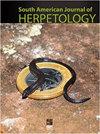通过公民科学和博物学家笔记评估蜥蜴尾巴分叉的发生率
IF 0.7
4区 生物学
Q4 ZOOLOGY
引用次数: 1
摘要
摘要蜥蜴的尾巴分叉是由尾巴自残后的异常再生过程引起的。最近的一项审查显示,近一半的记录来自社交媒体,其中一个代表性较低的家庭是Liolaemidae(一例)。Liolaemus属主要分布在安第斯山脉南部的国家,这些国家的尾分叉报告数量很少。Liolaemus尾巴分叉发生率低是一种真实的生物现象,还是只是一种采样假象?由于缺乏有针对性的搜索,而且该群体的物种数量众多,我们预计广泛的调查将大大增加病例数量。我们使用西班牙语、葡萄牙语和英语的搜索词回顾了科学文献、互联网网站和社交媒体(Instagram、Facebook、Flickr和iNaturalist,2020)。我们发现了与7个物种对应的16个尾部分叉事件,包括一个新的野外观测。所有分叉都发生在尾部的远半部,与所描述的趋势一致。细尾鲎是最常见的记录物种,这可以通过其在城市和自然地区的存在来解释。同样的过采样偏差可能会影响所有记录的地理分布。我们的实地观察可能相当于有记录以来第一次看到尾巴分叉的蜥蜴。通过社交媒体的大多数记录,这项研究证明了公民科学与记录罕见事件的相关性。但同时,这也是一个警告,需要对自然史和博物馆工作进行更多的学术验证。本文章由计算机程序翻译,如有差异,请以英文原文为准。
Tail Bifurcation Incidence in Liolaemus Lizards Assessed through Citizen Science and Naturalist Notes
Abstract. Tail bifurcation in lizards is caused by an anomalous regeneration process after tail autotomy. A recent review shows that nearly half of the records came from social media and one of the less represented families was Liolaemidae (one case). The genus Liolaemus is mostly distributed along countries in the southern Andes, which have low numbers of tail bifurcation reports. Is the low incidence of tail bifurcation in Liolaemus a real biological phenomenon, or just a sampling artifact? Due to the lack of targeted searches and the large number of species on this group, we expect that an extensive survey will significantly increase the number of cases. We reviewed the scientific literature, internet sites, and social media (Instagram, Facebook, Flickr, and iNaturalist, 2020) using search terms in Spanish, Portuguese, and English. We found 16 tail bifurcation events corresponding to seven species, including a novel field observation. All bifurcations occur on the distal half of the tail congruently with described trends. Liolaemus tenuis was the most commonly recorded species, which could be explained by its presence in urban and natural areas. The same oversampling bias might affect the geographic distribution of all records. Our field observation might correspond to the first documented re-sight of a lizard with bifurcated tail. With the majority of records from social media, this study exemplifies the relevance of citizen science to document rare events. But, at the same time, it is a warning call for the need of more academic validation of the natural history and museum-based work.
求助全文
通过发布文献求助,成功后即可免费获取论文全文。
去求助
来源期刊
CiteScore
1.50
自引率
0.00%
发文量
10
期刊介绍:
The South American Journal of Herpetology (SAJH) is an international journal published by the Brazilian Society of Herpetology that aims to provide an effective medium of communication for the international herpetological community. SAJH publishes peer-reviewed original contributions on all subjects related to the biology of amphibians and reptiles, including descriptive, comparative, inferential, and experimental studies and taxa from anywhere in the world, as well as theoretical studies that explore principles and methods.

 求助内容:
求助内容: 应助结果提醒方式:
应助结果提醒方式:


